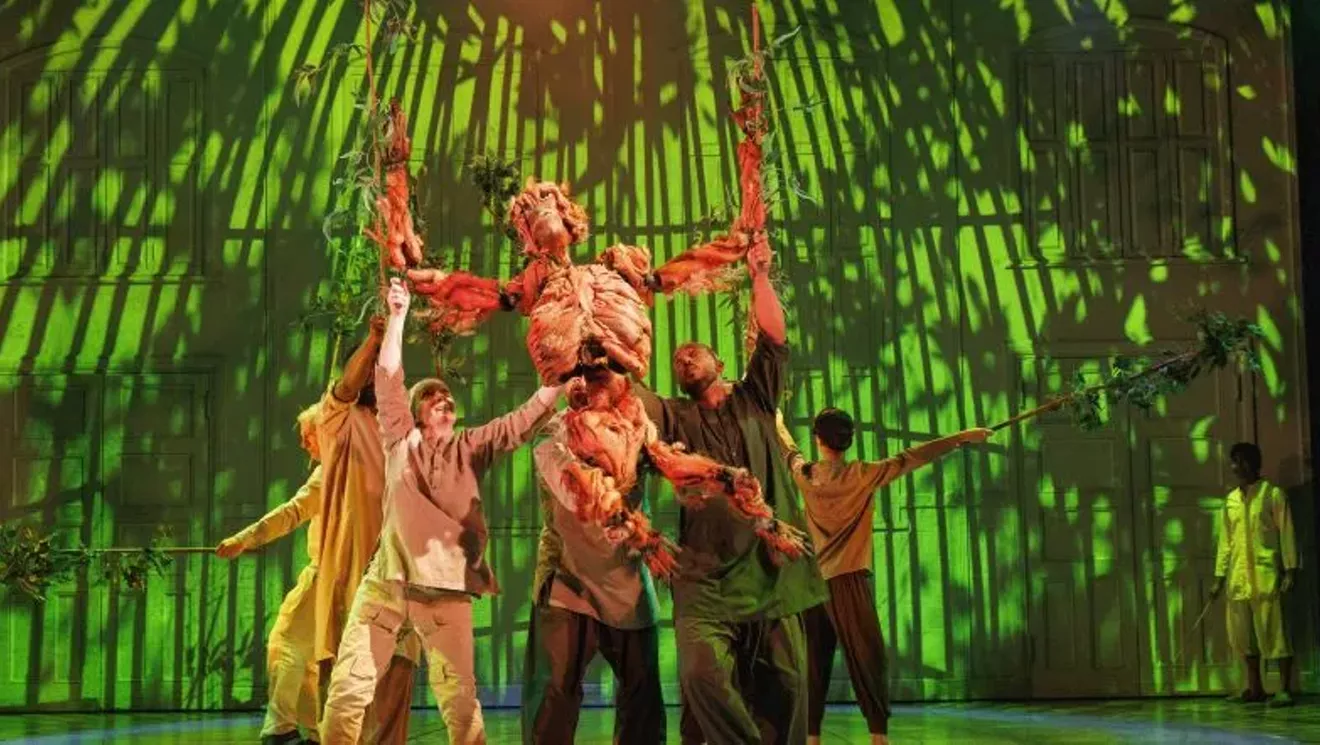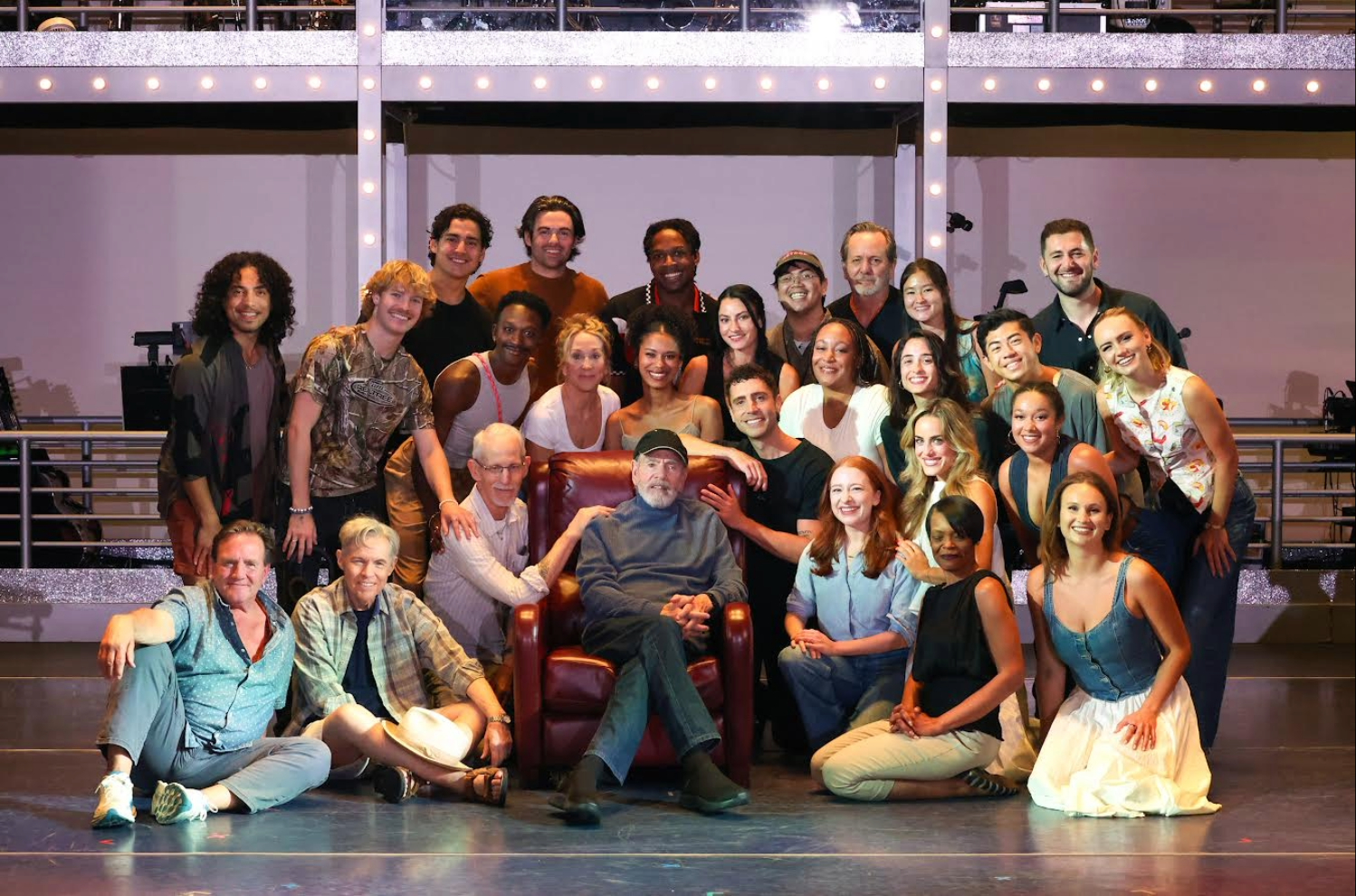Review: The Life of Pi at Broadway at the Hobby

That classic icon from vaudeville and film, the great curmudgeon W.C. Fields said it best, “Never work with kids and animals.”
But he never worked with Richard Parker (the tiger). Fields would have met his match. A superstar without equal, on view in Life of Pi from Broadway at the Hobby, what a magnificent and oh-so-animalistic Bengal tiger, who shares a lifeboat with lone survivor Pi after a storm capsizes the freighter on which his family and remnants of the family zoo in Pondicherry, India, go down with the ship. His arduous adventure with his feline shipmate, who eyes him hungrily throughout, lasts 227 days, the last few two weeks without water.
We first meet this gorgeous jungle cat in the opening scenes at the zoo where he is fed Pi’s beloved goat. Pi hates him after that, and that encounter forms his disgust and wild anger when the tiger swims toward and upon the lifeboat. The struggle is fierce, using all the technology of premiere stagecraft and wizardry at the creators’ disposal. The entire play is one of wonder, make-believe, base animal instincts, blood and guts, and transcendence. It is a beauty of a show and should not be missed.
Not since the Lion King’s opening prologue, where the denizens of the Veldt prance, fly, scramble, and lumber down the theater aisle and up to the stage where Pride Rock beckons, has there been such munificence of staging and imagination. It takes your breath away, as it transports you back to childhood and the magic of live theater and the wonder of make-believe.
We see the puppeteers, like Japanese Bunraku, but they instantly disappear, shadowy figures, and all we see is the animal, be it orangutan, zebra, hyena, or butterflies, star constellations, a giraffe at the zoo peeking through his enclosure, neon fish darting through the Pacific, or Pi on his make-shift raft as he paddles to get just far enough away from growling Parker reigning from the lifeboat. The stagehands are right in view as they pull the raft to and fro from the sides of the stage, but we’re so enchanted by what is happening to Pi (and to the tiger) that we only see the drama, what’s in front of us. If this isn’t theater pixie dust, I don’t know what is.
While all eyes are glued to Richard Parker, whether snoozing near the bow or grabbing a passing fish or chomping on that horrid hyena and tearing out his throat, there is a story to tell, which is the reason Yann Martel wrote his book and Ang Lee filmed it in 2012. Of course, Lee had all the CGI in the world to create Parker and the ocean and the stars, but theater has something even better – our imagination. Photo-realism can’t compete with that. That’s the theater’s ace up its sleeve. We don’t need vistas, give us a taste and we’ll fill it in.
That’s exactly what director Max Webster, adapter Lolita Chakrabarti, set and costume designer Tim Hatley, projection designer Andrzej Goulding, and the puppet wizards Nick Barner and Finn Caldwell weave so well together, along with sumptuous sound design by Carolyn Downing, and an Indian percussive soundtrack from Andrew T. Mackay. It all melds together flawlessly.
While the play bounces back and forth from Mexican hospital room where Pi is treated for trauma after his harrowing travels, he is grilled by a persistent insurance adjuster to get the real reason for the accident. Pi goes into flashbacks, like a psychic encounter, and relates his magic realism tale. Is he dreaming all this? Was it real? Did Pi make friends with his captive tiger? Or is there another story, certainly one more grisly that involves people, not zoo animals, onboard the lifeboat? What was their fate? And is this latest tall tale true?
Pi’s story is one of survival, forgiveness, family loss, family love, all bound up in a National Geographic documentary.
On opening night, just before Richard Parker was to make his zoo appearance, the curtain was rung down and a “stop show” announcement was broadcast. Taha Mandviwala (Pi) would be replaced by this tour’s alternative Pi, Savidu Geevaratne. We never were told of Mandviwala’s fate, but we hope he is all right. He was jumping on and off his hospital bed with abandon, and perhaps he sprained his foot. We wish him well, but Geevaratne spelled him with force, youthful ardor, and an athletic physicality that served him well as he ran around the lifeboat to avoid the ravenous Parker. His pleas to his three faiths – Christianity, Buddhism, and Islam – whenever life gave him a jolt were impressive indeed.
But, really, who can hold a stage when a star appears. Richard Parker, along with Joey from War Horse, and maybe Toto from The Wizard of Oz, has star wattage that eclipses Taylor Swift. I mean, you can’t take your eyes off him. He purrs, roars, growls with majestic command; he prowls with muscular sleekness; he’s lithe yet deadly. I suppose you’re supposed to hate his feral, take-no-prisoners attitude, but we can’t, we just can’t. He’s too magnificent a creature. We want to cuddle, like Pi does near the end when they are both famished and exhausted on the beach.
There are eight actors who inhabit Parker, and three animate him for each performance. One moves the head, who we see standing by him; one is crouched inside to work his front legs, and one is bent over to move his back legs and tail. It is must be a grueling physical workout to perform this role, but everything is graceful and smooth. Amazing, really. But the only actor I know for sure who was one of the three was Toussaint Jeanlouis, because you could match his Playbill bio picture with the actor moving Parker’s head. And he was the only one seen, except at the curtain call, which naturally brought down the house for the talented trio.
Watching puppets get gored and eviscerated may not be appropriate for youngsters, but this is animal life in the raw and they are only puppets, so maybe Life of Pi would be all right for them. But it sure would teach them – and show them – in no uncertain terms how magical and alive live theater is. Highly recommended, the wonders onstage – and Mr. Parker! – will leave you breathless.
Life of Pi continues through August 24 at 7:30 p.m. Tuesday through Saturday; 2 p.m. and 7:30 p.m. Saturday; and 1:30 p.m. and 7 p.m. Sunday at the Hobby Center, 800 Bagby. For more information, call 713-315-7625 or visit thehobbycenter.org or broadwayatthehobbycenter.com. $40-$100.40.

Reign Bowers is an outdoor enthusiast, adventure seeker, and storyteller passionate about exploring nature’s wonders. As the creator of SuperheroineLinks.com, Reign shares inspiring stories, practical tips, and expert insights to empower others—especially women—to embrace the great outdoors with confidence.




Post Comment